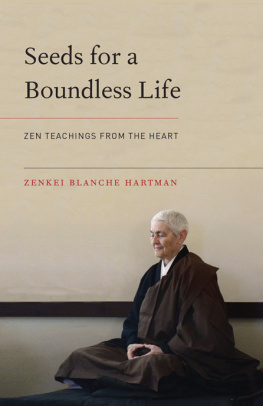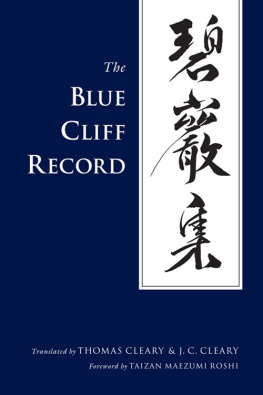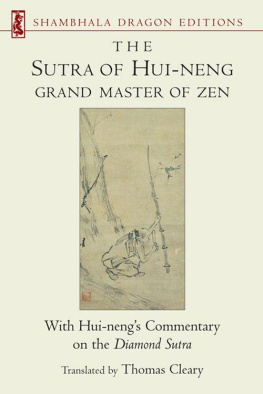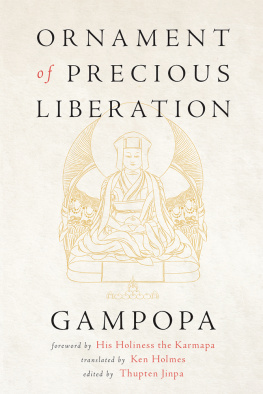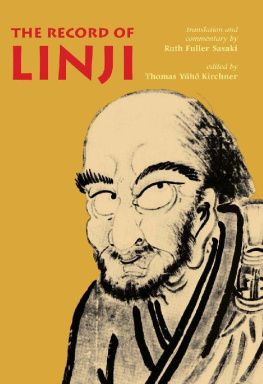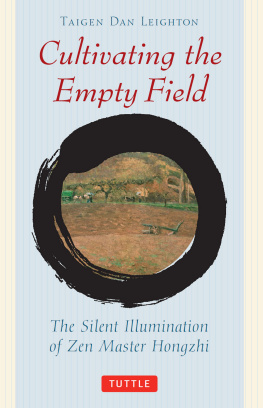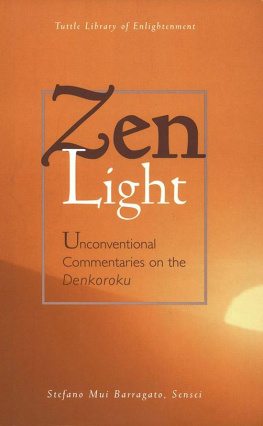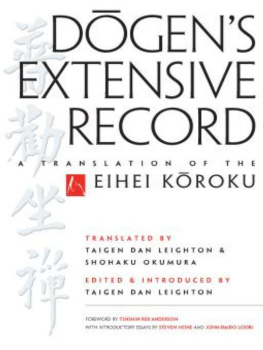All rights reserved.
No part of this book may be reproduced in any form or by any means, electronic or mechanical, including photography, recording, or by any information storage and retrieval system or technologies now known or later developed, without permission in writing from the publisher.
Keizan, 1268-1325.
[Denkroku. English]
The record of transmitting the light : Zen master Keizans denkoroku / translated by Francis Dojun Cook; foreword by John Daido Loori. 1st Wisdom ed.
p. cm.
Includes bibliographical references.
1. StshEarly works to 1800. 2. Priests, ZenBiographyEarly works to 1800.
I. Cook, Francis Harold, 1930 II. Title
Interior designed by Stephanie Doyle. Cover designed by Rick Snizik.
Dedicated to my wife, Elizabeth B. Cook,
with thanks for so many good things
FOREWORD
The Record of Transmitting the Light is a work that many that rank alongside Zen Master Dogens Shobogenzo as a major classic of Japanese Soto Zen. It documents the enlightenment experience and transmission of the Dharma through successive generations beginning with Shakyamuni Buddha down through Zen Master Koun Ejo, Dogens successor. The collected cases and accompanying commentary and poems by Zen Master Keizan are used in several modern lineages as part of koan study.
Keizan Jokin was born in 1268, fifteen years after the death of the great Master Dogen in 1253. He studied Zen under Dogens first successor Ejo, and then continued with Zen Master Tettsu Gikai, Ejos successor at Eihei-ji. He played a pivotal role in the development and expansion of Japanese Soto Zen, which earned him the title of Great Ancestor. Master Keizan is held in as high regard as Master Dogen, and has in fact been referred to as the mother of Japanese Soto Zen, while Dogen is considered the father.
After the death of Dogen in 1253, while Gikai was the third abbot of Eihei-ji, factional splits began to develop at Eihei-ji among monks of various other schools of Buddhism, such as the Tendai and Daruma lines. Master Gikai, then in his seventies, found himself at the center of the conflict and was ultimately banished from Eihei-ji. He took up residency at the gatehouse of the monastery, and although he had Ejos full trusthad in fact received transmission from himhe was forced to leave Eihei-ji and went on to establish Daijo-ji in Kaga (Ishikawa Prefecture).
The internal disputes and disorder became quite serious and began to threaten the very existence and continuance of the Japanese Soto lineage that was established by Dogen. Disciples left Eihei-ji. Supporters decreased in number. The vital and vigorous atmosphere that was originally established at the Eihei-ji monastic community began to disintegrate.
By this time, Master Keizan, having now succeeded Gikai as the second abbot of Daijo-ji, began a series of talks tracing the lineage of the rightly transmitted Buddhadharma from India to China, and from China to Japan, in an attempt to confirm that the teaching of the essence of the treasury of the true Dharma eye rests in zazen and realizationa point that had became lost as a result of the ongoing disputes at Eihei-ji. These talks were later collected as The Record of Transmitting the Light.
The word light in the title refers to the enlightenment experience that was transmitted, mind to mind, generation to generation, from Shakyamuni Buddha through twenty-eight ancestors in India and twenty-three ancestors in China, and finally carried from China to Japan by Dogen and transmitted to Ejo. The Record was Keizans attempt to heal the rift that had developed at Eihei-ji and to assert the legitimacy of the lineage that master Dogen carried from China. He thus attempted to fend off much of the criticism of Gikai, as well as to assert his own legitimacy and the legitimacy of his successors. Dogen himself had begun to establish the legitimacy of the lineage, but had not completed this work before his death.
Slowly, the sangha of Eihei-ji began to heal and the vitality of the practice returned. Keizan then established Soji-ji, and along with Eihei-ji, these two became the head monasteries of the Japanese Soto Zen tradition, and remain so to this day.
After establishing Soji-ji, Keizan traveled around Japan creating thousands of temples within his lineage. At its peak, the Japanese Soto School had about twenty-five thousand temples with over thirty thousand priests and some ten million followers. It becameand remainsthe largest Buddhist denomination in Japan. The propagation philosophy of Keizan is embodied today in the Soto School of Japan where it promotes the international development of Soto Zen. In the early part of the twentieth century, Japanese Soto Zen Buddhism began to spread to Europe, America, and southeast Asia. Today it is one of the largest Buddhist schools in the West.
In collecting the stories that make up The Record of Transmitting the Light, Keizan traced his own lineage back through history to Shakyamuni Buddha. The fifty-three accounts he recorded present historical information on the bloodline of Keizans Dharma ancestors as documented in the Ancestral Lineage of Succession, a document every Soto priest receives at the time of Dharma transmission. But more important, each anecdote is also a koan Keizans students had to unravel, and in time the Record became established as a koan collection for future generations of Zen students to contemplate.
Koans appear in a number of different ways in the traditional records of Zen Buddhism. In The Record of Transmitting the Light each koan is presented as the biography of one of the Zen masters. Koans also appear as individual cases collected in the various records of the masters, usually by a later-generation disciple. These koans or public cases usually contain factual information regarding the teachers training, teaching career, birth, and death, as well as a dialogue or dialogues between master and disciples, contemporaries, or visitors. During the Song Dynasty in China, several masters collected koans they regarded as being particularly valuable for the training of their own students. The masters then usually added to the koan their own commentary or verse, as both a challenge and a helpful pointer for their students.
At the time Keizan delivered the discourses in the Record, three of the major koan collections were already in existence. The Blue Cliff Record, the oldest of the three, was introduced to Japan by Dogen in 1227. Dogen had just completed five years of study in China with his teacher, Master Tiantong Rujing, and had received the Soto transmission. Shortly before leaving for Japan, he discovered a copy of The Blue Cliff Record and spent his entire last night in China hand-copying it. This text is known within the Soto School as the One-night Blue Cliff Record.
The second koan collection, The Book of Serenity, essentially follows the same form as its predecessor, The Blue Cliff Record. The third collection was The Gateless Gate. Its form is less poetic and literary than that of its predecessors, but rather more direct and straightforward in its exposition of and commentary on the recorded dialogues.
These three collections no doubt provided a model for Keizans work. Each of the chapters in the Record consists of four basic sections. The first is the main case, which includes the essential elements that sparked the realization and transmission of the disciple, mind to mind, from the master. Next is a section with biographical and historical information to set the context in which the encounter is taking place. The third is Keizans discourse or teisho on the case. Here Keizan guides the student to realize the koan by directly pointing. Teisho are said to be dark to the mind but radiant to the heart, so they must be received with the whole body and mind, rather than through linear, discursive thought. They challenge students to make a quantum leap of consciousness and see directly into the koan, thereby turning the ancestors realization into an intimate part of their own being. The fourth and last section is Keizans verse, a few lines that capture the essential point of the koan, following the Zen tradition in which students or teachers present in poetic form their understanding of a particular point in the teachings.


